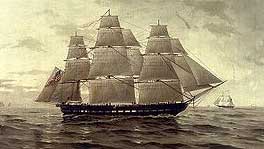
USS Chesapeake, from frigate to mill
Last Sunday, we posted about the authorization for the construction of the first six frigates for the US Navy in 1794. The folks at Maritime Great Britain were kind enough to pass along two related stories.
One of the six frigates, the USS Constitution is still in service and is said to be the world’s oldest floating commissioned naval vessel. The Constitution has an odd, tangential connection to the oldest British warship still afloat, HMS Trincomalee, a Leda class frigate launched in 1817. Because of shortages of oak, the Trincomalee was built in India of teak. The plans for the construction of the ship were being carried to India aboard the HMS Java in 1812, during the second war with the ex-North American colonies. USS Constitution defeated the Java, which subsequently sank, taking the plans with her. Another set of plans for the construction of the Trincomalee did finally arrive in India, but only after a delay of several months.
During the war of 1812 the USS Constitution defeated five British warships, HMS Guerriere, Java, Pictou, Cyane and Levant, as well as capturing a number of merchant vessels. Her battle with HMS Guerriere earned her the nickname “Old Ironsides” after a British broadside bounced off her hull.
USS Chesapeake was not as successful as the USS Constitution but played at least as large a role in history. In 1807, HMS Leopard while searching for British deserters fired on the Chesapeake killing three and injuring 18 of her crew. What would become known as the Chesapeake-Leopard Affair significantly increased tensions between the two nations in the run up to the War of 1812.
In 1813 the Chesapeake was taken by HMS Shannon in a bloody ship to ship battle. The Chesapeake‘s Captain James Lawrence was mortally wounded. His dying words were “Don’t give up the ship.” Three months later the phrase was adopted by Commodore Perry who flew “Don’t Give up the Ship” on his battle flag during his victory at the Battle of Lake Erie.
The USS Chesapeake was taken into the Royal Navy as the HMS Chesapeake until she was broken up in 1819. In 1820 her timbers were used to build a mill in Wickham, England which continued to operate until 1975. Today the Chesapeake Mill is home to antique dealers and gift shops.

Shouldn’t that be 1794 not 1764?
Of course it should. I fixed it. Thank you for catching my fumble fingered mistake.